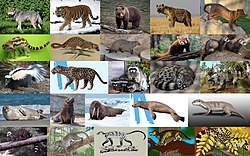| Carnivoramorpha | |
|---|---|
 | |
| Diversity of Carnivoramorpha | |
| Scientific classification | |
| Kingdom: | Animalia |
| Phylum: | Chordata |
| Class: | Mammalia |
| Mirorder: | Ferae |
| Clade: | Pan-Carnivora |
| Clade: | Carnivoramorpha Wyss & Flynn, 1993 [1] |
| Subgroups | |
[see classification] | |
| Synonyms | |
Carnivoramorpha ("carnivoran-like forms") is a clade of placental mammals of clade Pan-Carnivora from mirorder Ferae, that includes the modern order Carnivora as well as extinct stem-group relatives that are more closely related to Carnivora proper than to "creodonts". [4] [5]



